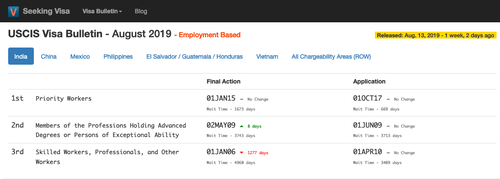The Immigration and Nationality Act (INA) sets a limit on the number of Green Cards that can be issued every year. For the current fiscal year of 2019, that limit is 226,000 for family-based and 141,918 for employment-based green cards respectively. Although 366,000 might look like a lot of green cards, there are many more applicants per year. Moreover, there is a country cap of 7%, which means no single country can get more that 25,754 green cards in a year. So any country that is oversubscribed, meaning the number of applicants from that country exceed the cap, will end up having a backlog and this backlog will grow every year for extremely oversubscribed countries. These countries (China, India, Mexico, Philippines, El Salvador, Guatemala, Honduras and Vietnam) have a country specific backlog queue. The rest of the countries fall into the general All Chargeability queue. The USCIS Visa Bulletin publishes the wait times for these backlogs.
There are two different ways you can get in line for securing a US green card. One is by filing your I-130 Petition for Alien Relative (family-based) or the other is by filing your I-140 Petition for Alien Worker (employment-based). There are different bulletins published for the family-based and employment based applicants. Consequently for you, this will mean your wait time depends on the type of green card you have applied.
Here's an example of the India employment-based chart shown at Seeking Visa:

Before you figure out your wait time for getting an approved green card, it's useful for you to know a few key terms:
Once you know these terms, you can find your wait time by looking at the correct visa bulletin chart.
Here's an example: If the priority date on your employment based Form I-140 for the 3rd category is Jul, 04 2016, your country of chargeability is India and the latest USCIS Visa Bulletin shows that the cutoff date for India employment based 3rd category is Jul, 01 2009, then you're not eligible to apply for a Green Card yet. You'll have to wait to apply until the cutoff date is later than your priority date.
Being "current" means that you are immediately eligible to apply for a green card. There are two ways to be current based on the cutoff date shown on the visa bulletin chart for your specific visa type:
A "U" just means that for your country of chargeability, visa type and visa category, green cards are "Unavailable" or in other words, there is extremely high demand for green cards.
Please note that you cannot always use the Application Filing Date to get an EAD even if it is current. To check if you can use it for a specific bulletin month, please visit the USCIS site here.
The USCIS Visa Bulletin is released every month. Recent trends indicate is it usually released on or before the 15th of every month. You can find out when the latest bulletin was released by checking Seeking Visa's Employment Bulletin or Family Bulletin and looking at the "Released" information in the top-right corner:
This is the easy part - you can subscribe to get an instant email alert from Seeking Visa. Just select "Visa Bulletin" from the top menu and put in your email address and select "Notify Me!"
You will be the first to know when a new bulletin is released. Check the Employment Bulletin or the Family Bulletin.